One of the most frequent concerns surrounding a fruit-based diet is protein intake. Do we get enough protein? The common-sense answer is: similar to how the chimpanzees get their proteins! While there certainly is valid reasoning behind this, the protein question should be addressed in more detail because humans do not live in a natural habitat like chimps do! So let’s look into protein intake on a fruit-based diet, in particular frugivore and fruitarian.
Feel free to ask or comment on anything fruit and diet-related below! We are happy to learn from your experiences. 🙂
For quick readers:
1. Protein sources on the fruitarian and frugivore diet
Where do we get proteins from on a fruit diet? All raw foods, including fruits, contain some amount of proteins. Many larger mammals in the wild are plant-eaters. And chimpanzees in the wild get their proteins mostly from tropical fruits and tender leaves. The amount of proteins in a fruit diet largely depends on fruit quality but also on additional foods like nuts, greens, etc.
There are basically two types of high-fruit diets that differ in terms of protein sources: frugivore and fruitarian.
While protein can certainly be a limiting factor on the fruit-only fruitarian diet, the frugivore diet has plenty of protein-rich foods. After all, frugivores in nature have healthy muscle mass.
The diet of chimpanzees includes mainly tropical fruits, tender leaves, nuts, and other parts of tropical trees, but also small amounts of animal-based foods (read more below). Comparing the frugivorous apes’ diet can help us understand a fruit-based diet in nature and how to apply it to humans. Find a more detailed comparison between a frugivore and a fruitarian diet here.
Overview high-fruit diets:
- Fruitarian diet: Fruits
- Frugivorous diet (“Frugivore Diet”): Fruits, nuts, greens, veggies, seeds,
- Diet of chimpanzees in the wild (highly frugivorous): Fruits, greens, nuts, tubers, seeds, and a small percentage (around 6 %) of animal-based foods like eggs, insects, rarely crabs and meat
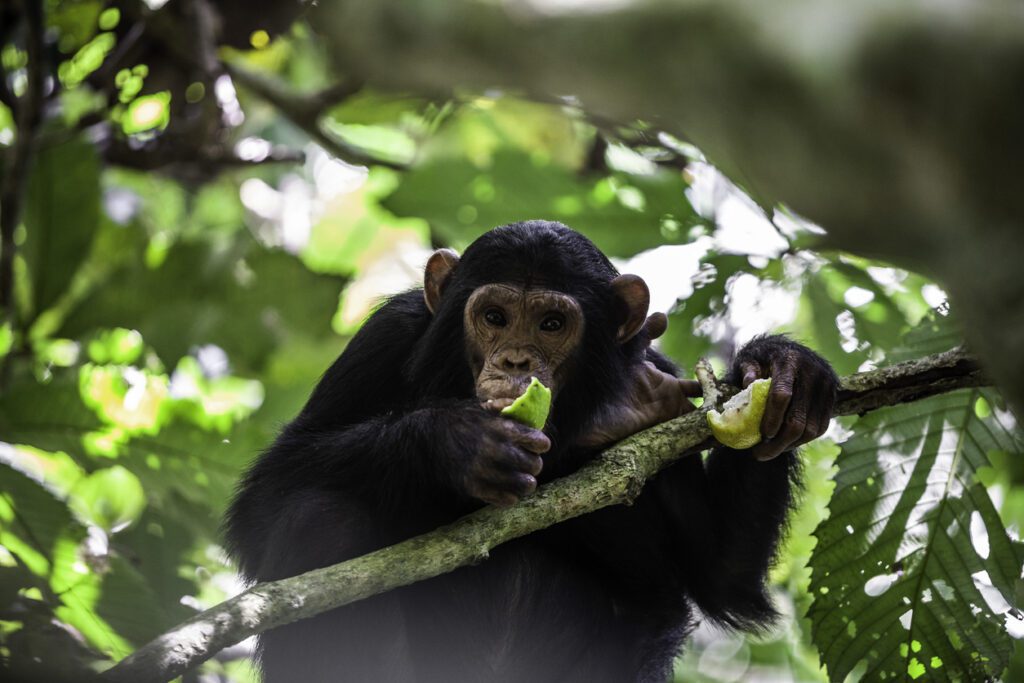
As we can see, a fruit-based diet can highly vary in the foods that are included! So let’s get into the detail on how much protein the different food contains: How much protein can we get from fruits, nuts, and greens?
2. How much protein do fruits contain?
Despite common perception, fruits do contain an amount of protein that counts towards the overall intake of protein in our diet! Most tropical fruits contain around 2 grams per 100 grams, with a variation from around 0.8-2.4 grams. This seems little at first, but around 80 grams of fruit are water! 100 grams contains ca. 1 gram of protein, which is 1 % of its weight – but it is 5 % of its dry weight! For açai berry or passion fruit, this would even be higher, around 10%! A high-protein fruit like durian contains up to 35 grams per kilo, which is way more than half of what we require daily (see below)!
Different fruits and their protein and sugar content
Generally, watery and temperate fruits contain more water and less protein. It is important to note that on a fruit-based diet, tropical fruits are essential for providing the bulk of calories and nutrients. Temperate fruits can not sustain frugivorous primates, as most types have not evolved with mammals – but with birds – as a food source (read more here).
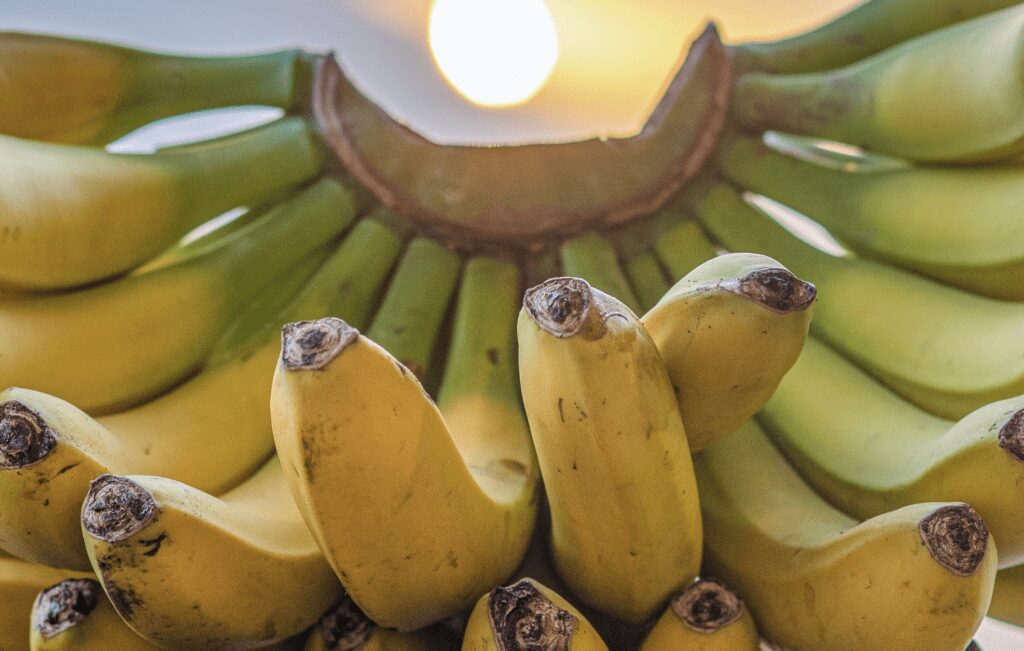
| Fruit Type | Protein (g) | Sugar (g) |
|---|---|---|
| Mango | 0.8 | 14 |
| Lucuma | 1.5-2.3 | 28 |
| Passion fruit | 2.2 | 11 |
| Durian | 1.4-3.5 | 16-35 |
| Bananas | 1.1 | 12 |
| Açai berry | 1.9 | 6 |
| Jackfruit | 1.8 | 31 |
| Avocados | 2 | 1 |
| Cherimoya | 2.5 | 21 |
| Guava | 2.6 | 9 |
| Papaya | 0.6 | 10 |
| Mangosteen | 1 | 35 |
| Dragon fruits | 1.2 | 10 |
| Lychee | 0.8 | 29 |
| Apple | 0.3 | 10 |
| Plums | 0.7 | 10 |
| Cherries | 1 | 8 |
| Blueberries | 0.9 | 9 |
| Apricots | 1.4 | 9 |
Protein content in fruit compared to nuts, greens and animal-based foods
Here is an overview of the approximate protein content of different foods in the fruitarian, frugivore, and chimpanzee diets. These values make it easier to calculate the amount of protein in our daily meals (see an example in the section below):
| Protein content in grams (equals %) | |
|---|---|
| 100 g tropical fruits | 0.6-3.5 |
| 100 g temperate fruits | 0.3-1.4 |
| 100 g nuts | 9-21 |
| 100 g greens/salad | 1.6-2.9 |
| 100 g muscle meat | 20-25 |
| 100 g eggs | 13 |
| 100 g tubers | 0.9-2.2 |
3. How much protein do we get on a frugivore diet?
Where do we get proteins from on a fruit diet? All raw, unprocessed foods, including fruits, contain some amount of protein. Many larger mammals in the wild are plant-eaters. For example, elephants are non-ruminant herbivores that eat fruits, too. Chimpanzees in the wild get their proteins mostly from tropical fruits and nuts (see below). The primatologist Katherine Milton, who studies the nutrition of primates, calculated that a 41-kg heavy chimpanzee gets at least 48 grams of protein from (wild tropical) fruits alone (source)! Further, nuts contain nearly as much protein as meat, and green leaves also substantially contribute to the amount of protein in the diet of primates: “Young leaves from tropical trees are far more nutritious than I realized. In fact, the young tips have the same profile of essential amino acids as meat, although in lower concentrations,” said Milton. She said that leaf protein is perfectly good and clearly satisfies all the protein needs of the monkeys.” (source)
However, chimpanzees also eat small amounts of animal-based foods!
Now, here comes the clue: If you are able to get enough proteins on a fruit-based diet, is highly dependent on the food types (greens and nuts) and fruit type included in your diet. And on their quality. Be aware that wild tropical fruits contain more protein than cultivated ones (see below) and way more than temperate fruit!
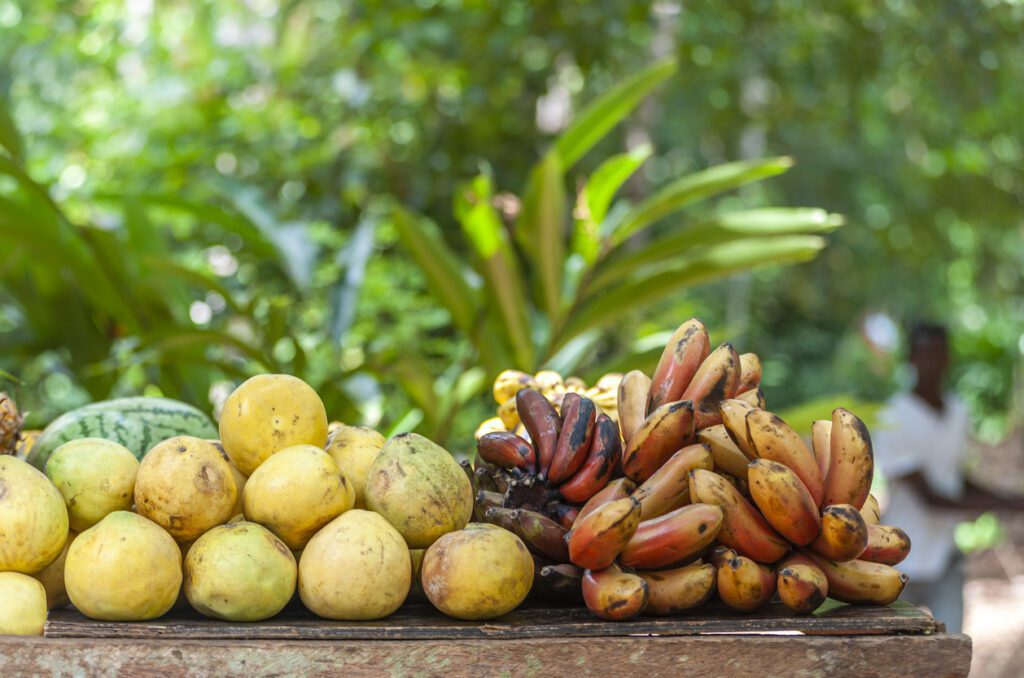
The frugivore diet provides the recommended amount of protein!
A frugivore diet can easily provide 50-53 grams of protein per day, which meets intake recommendations! This example of a day of frugivorous meals (ca 2000- 2500 calories) day contains the recommended daily intake of protein:
- One açai bowl with 200 grams açai berries and 3 bananas, plus added greens and chia seeds (650-700 calories)
- One handful of Brazil nuts (150-200 calories)
- One banana and one mango as a snack (200-250 calories)
- A fruit meal with a variety of fruits (300-400 calories)
- One handful of pecan nuts (150-200 calories)
- One large green salad with avocado and mangoes (300-400 calories)
- Banana Smoothie with coconut milk (250-350 calories)
Let’s calculate: The RDA for adults is a daily intake of around 50-55 grams of protein per day. If you consume the following meal in a day, you will get enough calories and 50-53 grams of protein:
| Meal / Food | Protein content (g) |
|---|---|
| 200 grams of açai berries: | 5 |
| 4 bananas | 8 |
| 2 handful of nuts | 3-5 |
| 1 Large green salad | 2 |
| Tropical fruit variety (ca. 2 kg) | 30 |
| 100 grams coconut milk: | 2 |
| Total | 50-53 |
Can we get enough protein on the fruit-only, fruitarian, diet?
What about protein content in a fruit-only fruitarian diet? As mentioned, a frugivore diet is fundamentally different regarding protein sources – the only protein sources are fruits! To get enough protein, the amount of fruits has to be increased to around However, protein intake through fruits alone can become a problem long term – which is why many fruitarians do this diet during limited periods of time. To stick to a fruitarian diet for a long time, we also have to have nearly unlimited access to high-quality tropical fruits. Long-term successful fruitarians often live in the tropics. Given these perfect conditions, we (theoretically) can get enough protein:
Let’s look at the 100 g of tropical fruits contain between 1-3.5 g of protein. If we take a value in the middle – 2 grams per 100 grams – we would need to consume nearly 3 kg of fruit daily. If we include a high-protein fruit (like durian), around 2 kilos can already reach the 50-55 grams we need per day! Is it possible? Sure, it is! Chimpanzees eat around 3-6 kilos of food in the wild – depending on the food type and body weight (a wide range between 25 – 70 kg) and calorie requirements!
Wild fruits contain more protein than modern cultivated ones!
A neglected but utterly important factor in deciding what to eat is to face the reality that we do not live in our natural habitat! Most of us do not have access to wild, ripe tropical fruits like chimpanzees do! Wild fruits do have a different nutritional profile: they contain more proteins, another carb composition, and more micronutrients (K. Milton, 1999).
“Humans clearly come from an evolutionary past in which hexose (fructose) – rather than sucrose-dominated fruits were consumed, and human digestive physiology should, therefore, be best adapted to a carbohydrate substrate similar to that of wild fruits. But, in addition, wild fruits differ in other respects from their cultivated counterparts. These include a high content of roughage – woody seeds, fibrous strands – as well as higher average protein levels, higher levels of many micronutrients … and , at times, considerable pectin.”
Kathrine Milton; 1999
This insight is another piece of the puzzle to understand how frugivores meet their nutritional needs!
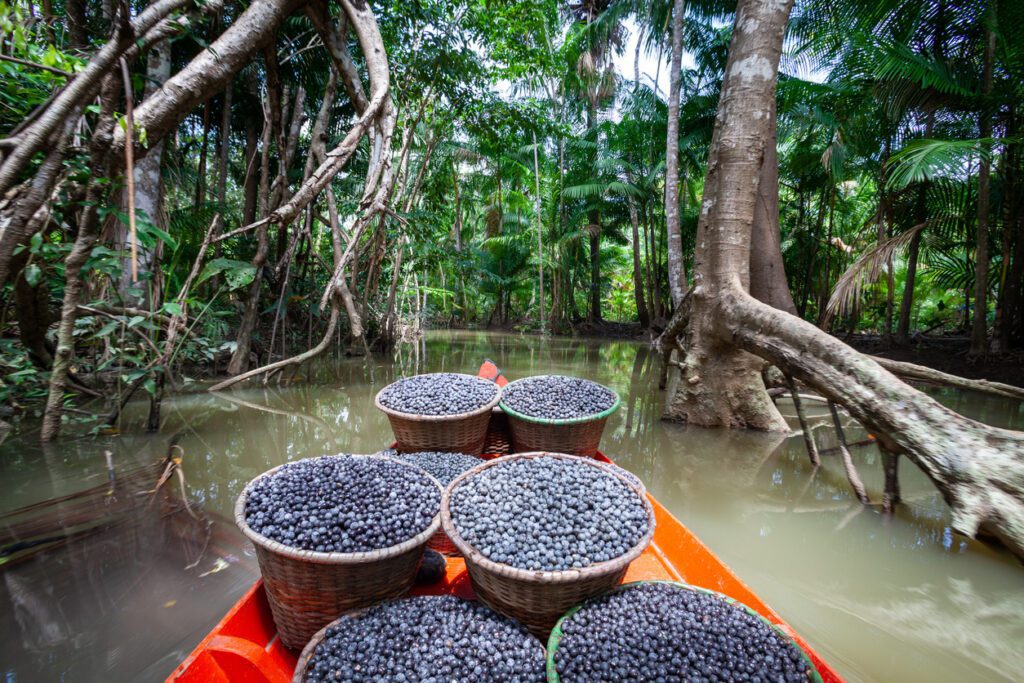
4. Chimpanzees get their protein mostly from fruits, greens, and some nuts
Chimpanzees are frugivores, but they hunt for meat sometimes. At first glimpse, an obvious explanation for hunting and meat eating in frugivorous animals is to acquire protein-rich foods. While this is a plausible possible cause, let’s not lose sight of the bigger picture: not all animals need to obtain protein from animal-based foods. And not all chimpanzees eat meat – hunting and meat-eating are mostly “male things” – and they are occasional. Thus, meat-eating might be optional for primates (i.e., chimpanzees) rather than obligatory!
Chimpanzees rely heavily on greens:
“The researchers stress that adult and juvenile male and female chimps in the park all still got most of their protein from fruits and nuts.”
Citation from PNAS article (2013) on anthropology research over 20 years.
While meat is certainly not a key factor for protein intake, chimpanzees do eat other (smaller) animal foods for more protein: insects, eggs, or sometimes crabs (see an example here). However, the average animal-based food intake of chimpanzees is low, around 6 % of their diet. The intake also underlies great seasonal and individual variety, which means that some individuals and some periods the apes do not eat animal food at all.
The idea that protein-rich foods must be a priority for frugivorous chimpanzees whenever available is actually undermined by the findings of leading primate researchers (summarized here by Takemoto, 2002):
“…chimpanzees preferred food items with high sugar content or caloric intake rate, regardless of protein content”
Takemoto, 2002
Are animal-based foods part of a frugivore diet?
Chimpanzees regularly eat insects, and males even hunt at times. But not all chimpanzees eat meat! Nuts do contain nearly as much protein as animal-based foods.
Do we need animal-based foods? Our instincts push us away from foraging this type of food in nature (raw); however, would we eat them as fallback foods if we were starving? Our more recent ancestors did when migrating into colder climatic areas, but they cooked those foods to make them safer and more palatable.
Here, we encounter many open questions, different opinions, and experiences! If we need foods other than fruits, nuts, and greens, it probably depends on our health, the habitat we live in, the types of foods we have access to, and how long we are doing this diet. Under optimal conditions, we most likely do not need animal-based foods, even in nature. And under sub-optimal conditions (most of us), we can avoid animal-based foods with other types of cooked foods and supplements if we wish.
Further, the “raw rule” might be helpful to answer some questions on how to do this the best way and identify the foods that are suitable for us: Would you eat it raw? Most of us are utterly repulsed by raw meat or insects, but, for example, not by raw milk and cheese in colder climates! However, this might be a cultural bias! By no way is milk a species-specific food – but it did serve as a survival food for humans in colder climates, where they did not find their nourishing fruits. So, for those of us who do not live in the perfect fruitarian or frugivore place, we all need to find the second best way. Read more about supplements in cold climates here.
5. Humans have evolved with a low-protein, high-carb diet!
Humans come from a highly frugivorous ancestry – a diet high in simple carbs! The modern high-protein, heavily animal-based diets have emerged as survival foods in cold climates, but our bodies are still that of biological frugivores because we have evolved as fruit-eaters in tropical, forested habitats. Humans are cultural omnivores, but our natural diet is highly frugivorous, which is why a high-carb/low-protein diets actually provide the type of macronutrient composition that our frugivorous body has adapted!
For example, human kidneys are not equipped to process a high-protein diet:
“…it is time to unleash the taboo and make it loud and clear that a high-protein diet is not as safe as claimed, as it may compromise kidney health…”
Kalantar-Zadeh et al., (2020)
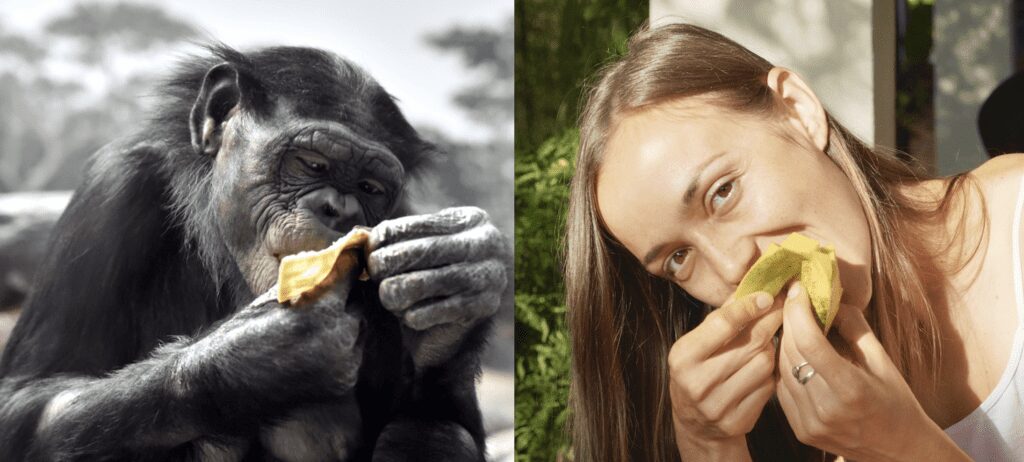
Our recent ancestors avoided excess protein by choosing meat high in fats while avoiding lean meat (read more here). Human kidneys are not adapted to excrete the amount of urea that carnivores do! Not surprisingly, the kidneys of species with different dietary ecologies (carnivores, omnivores, herbivores) are also different in their urea permeability proportional to their natural meat intake (Liu et al., 2010).
For this reason, the recycling of amino acids (see above) has a two-fold advantage: we do not need to get so much protein from diet, and the kidneys have a decreased workload! Kidneys are a key organ in detoxification and waste elimination:
Too much protein is often a bigger problem than too little…
Is the protein content in today’s average diet causing health issues? The average protein intake in Western countries exceeds the recommendations of about 50 grams by far: Americans consume around double the recommended amount – approximately 100 grams per day. Thus, too much protein, not low protein, is more likely to currently be a cause of poor health outcomes in our modern society! A fact that is sadly reflected in poor kidney health and slow, ineffective detoxification, which is rampant in most modern civilizations.
Why do carbs help maintain muscle mass?
How can the relatively low amount of protein in a high-fruit diet be enough? Carbs from fruits help maintain muscle mass and protein in the body by enabling the recycling of amino acids! We must understand that proteins are not “burnt” like energetic nutrients (sugar and fat). Instead, proteins are broken down into amino acids and are recycled (and even stored) if needed, while excessive amino acids are transformed into the waste product urea, filtered by the kidneys, and excreted via urine.
While amino acids potentially can be used as an energy source by the body, this is only a survival strategy: the body is only forced to use protein as an energy source when not enough primary fuels – sugars and fat – are available. As a consequence, we do not have to consume proteins in amounts as we do need energetic macronutrients, carbs, and fats! We still need to take in certain amounts of amino acids as building blocks, but we do not need nearly as much as most people believe we need – thanks to the re-using mechanisms.
Therefore, besides taking in some level of amino acids from the diet, consuming enough calories (carbs, fats) is essential for maintaining muscle mass and keeping protein levels! As evidence that a natural frugivorous diet (see here) can provide adequate protein for our needs, we can take chimpanzees, who can develop significant muscles on a high-fruit diet.
Conclusion
Is there a definite answer to whether we can get enough protein on a fruitarian diet? This ultimately depends on the definition of the diet (frugivore, fruitarian) and the quality and quantity of foods we can include. If we can access enough high-quality tropical fruits, greens, and nuts, a frugivore diet can easily provide the recommended amount of protein! Especially if you live in the tropics, this should not be a challenge – in contrast to colder climates. In this case, it can become necessary to include cooked foods, fallback foods, and supplements.
Want to know more about adopting a frugivore diet yourself? Check out our guide
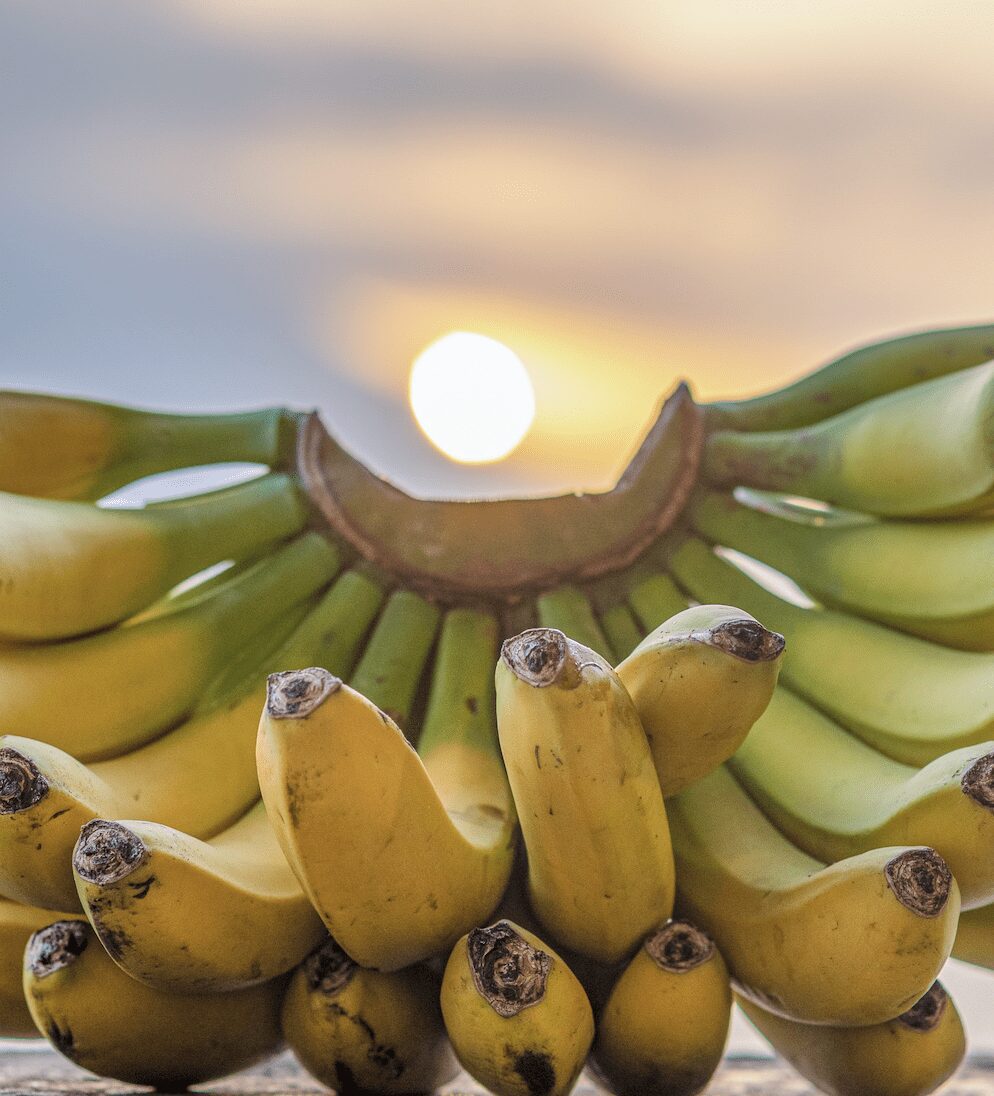
Go to How to do the Frugivore Diet
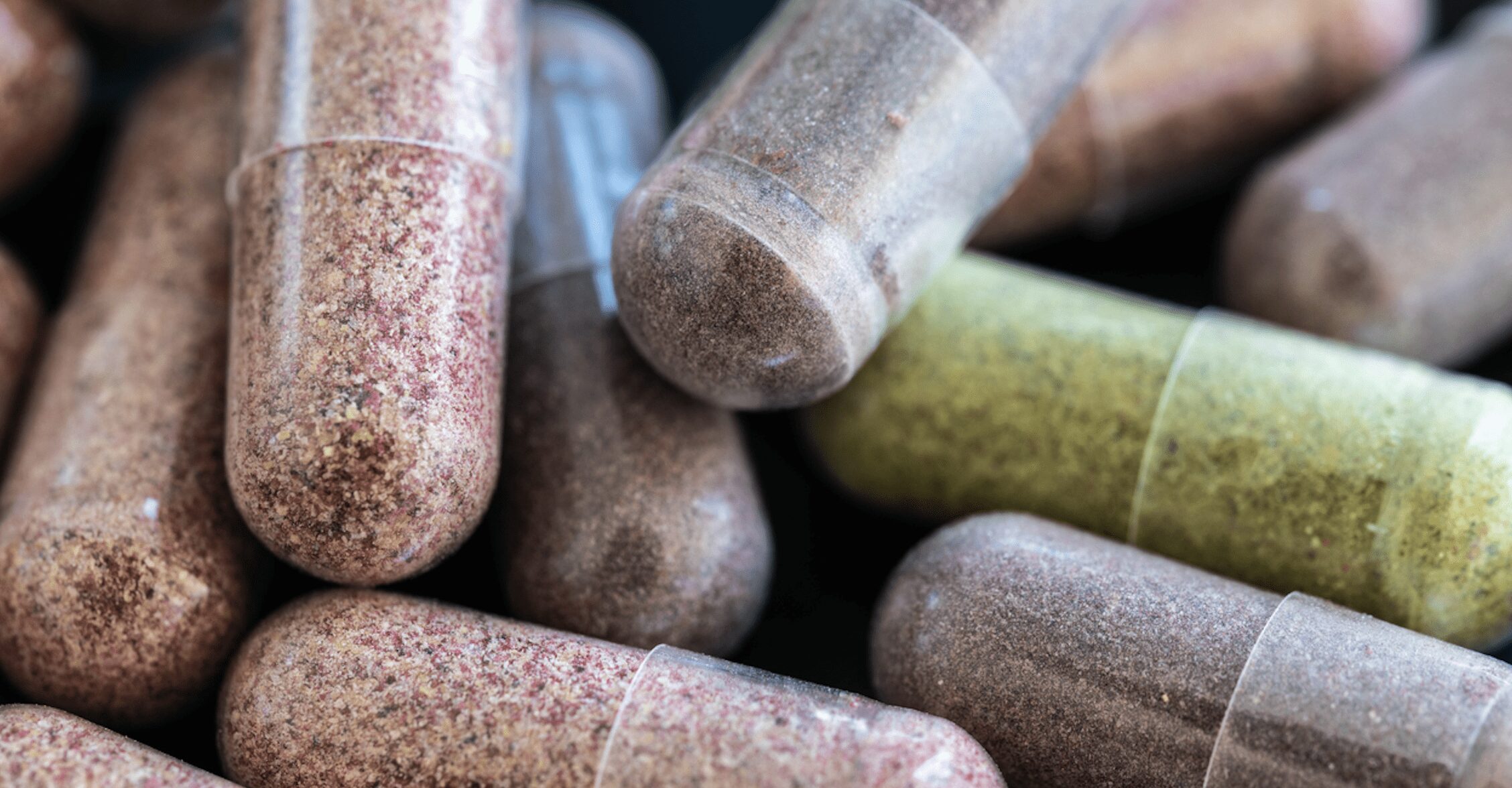
Find our Supplement Guide here

Are Humans Actually Frugivores? Read more here
References
- Author unknown; Adult male chimps regularly eat meat, unlike other chimps (2013). Available at: https://www.pnas.org/post/journal-club/adult-male-chimps-regularly-eat-meat-unlike-other-chimps (Accessed: April 26, 2023).
- Fooddata Central. Available at: https://fdc.nal.usda.gov/index.html (Accessed: April 26, 2023).
- Aziz, N., Jalil, A. (2019) “Bioactive compounds, nutritional value, and potential health benefits of indigenous durian (Durio Zibethinus Murr.): A Review,” Foods, 8(3), p. 96. Available at: https://doi.org/10.3390/foods8030096.
- LeWine H. E. (2022) How much protein do you need everyday? Harvard Health. Available at: https://www.health.harvard.edu/blog/how-much-protein-do-you-need-every-day-201506188096 (Accessed: April 26, 2023).
- Nutritional values for common foods and products. Nutritional Values For Common Foods And Products. Available at: https://www.nutritionvalue.org/ (Accessed: April 26, 2023).
- Milton, K. (1999) ‘A hypothesis to explain the role of meat-eating in human evolution’, Evolutionary Anthropology: Issues, News, and Reviews, 8(1), pp. 11–21. doi:10.1002/(sici)1520-6505(1999)8:1<11::aid-evan6>3.0.co;2-m.
- No author (2020) Buy a chimp a meal, Chimfunshi Wildlife Orphanage. Available at: https://chimfunshiwildlife.org/appeal/buy-a-chimp-a-meal/ (Accessed: April 26, 2023).
- What do chimps eat? A chimpanzee’s Diet & eating habits in the Wild African forests. (no date) Safari Partner. Available at: https://safaripartner.com/blog/what-do-chimps-eat (Accessed: April 28, 2023).
- Russ, J. (2022) Communication by chimpanzees improves cooperative hunting success, ASU News. ASU News. Available at: https://news.asu.edu/20220729-communication-chimpanzees-improves-cooperative-hunting-success (Accessed: April 26, 2023).
- Author unknown (2019) Chimpanzees fish for crabs. UZH. Available at: https://www.news.uzh.ch/en/articles/2019/Fishing-for-crabs.html (Accessed: April 26, 2023).
- H. Takemoto (2002) Phytochemical determination for leaf food choice by wild chimpanzees in Guinea, Bossou. Available at: https://www.greencorridor.info/data/Phytochemical_Determination_for_Leaf_Food_Choice_by_Wild_Chimpanzees_in_Guinea__Bossou.pdf (Accessed: July 23, 2023).
- Milton, K. (1999) “Nutritional characteristics of wild primate foods: Do the diets of our closest living relatives have lessons for us?,” Nutrition, 15(6), pp. 488–498. Available at: https://doi.org/10.1016/s0899-9007(99)00078-7.
- Kalantar-Zadeh, K., Kramer, H. M., Fouque, D. High-protein diet is bad for Kidney Health: Unleashing the Taboo. Nephrology Dialysis Transplantation (2019), doi:10.1093/ndt/gfz216.
- Liu L. et al., Erythrocyte permeability to urea and water: Comparative study in rodents, ruminants, carnivores, humans, and birds. Journal of Comparative Physiology B. 181, 65–72 (2010), doi:10.1007/s00360-010-0515-5.
- The citizen online (no date) * Whitewater assistant principal arrested for golf cart DUI | The Citizen Online. Available at: http://archive.thecitizen.com/node/17648.html (Accessed: 30 November 2023).
- Egan, S. (2017) How much protein do we need? The New York Times. Available at: https://www.nytimes.com/2017/07/28/well/eat/how-much-protein-do-we-need.html#:~:text=Most%20American%20adults%20eat%20about,nuts%2C%20broccoli%20and%20whole%20grains. (Accessed: April 26, 2023).


Add Comment